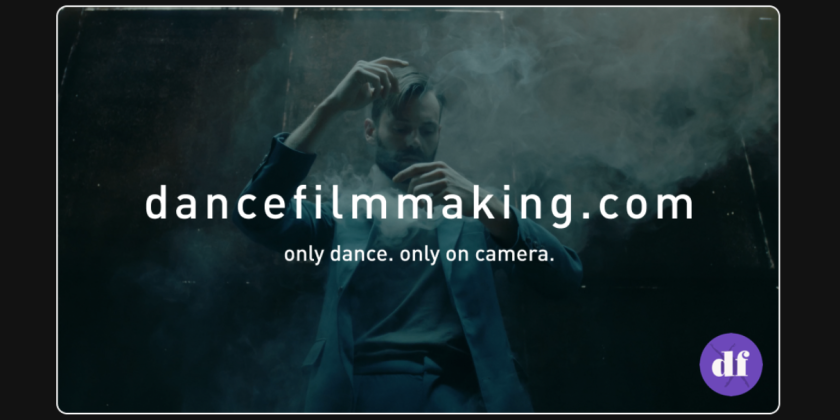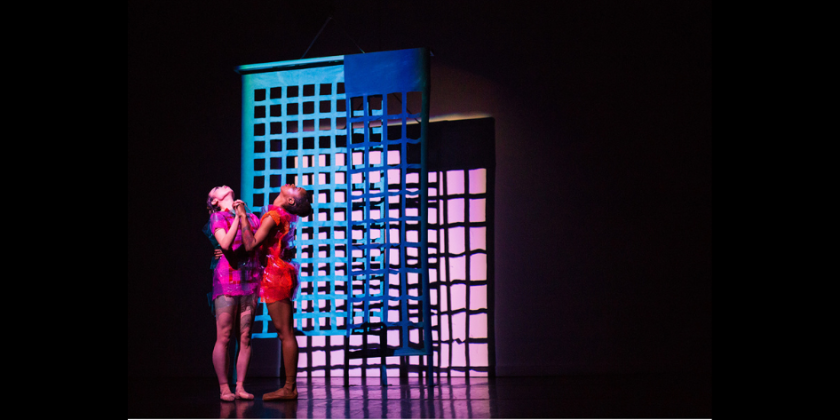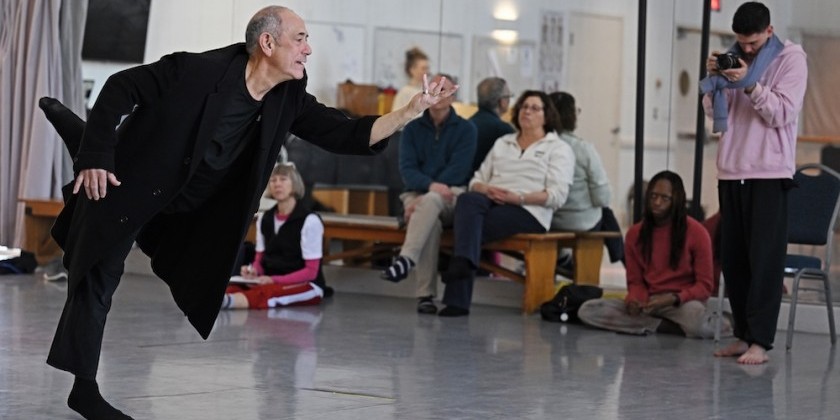THE DANCE ENTHUSIAST ASKS: Nadav Heyman and Genna Moroni on Creating the Netflix of Dance Filmmaking

Dancefilmmaking.com's First Annual Dance Film Awards Fall on Saturday, April 6th in LA
Festivals across the world celebrate the art of dance filmmaking, but, until recently, no central location existed to house this transformative work, which often withers away in the depths of YouTube or Vimeo. Enter dancefilmmaking.com. Described by founder Nadav Heyman as “the Netflix of dance filmmaking, but with no subscription fee,” the platform has become a beacon for artists exploring the dynamic interplay between choreography and cinematography.
Not even a year old, the site is already proving to be an essential home for dozens of dance films, from shorts to narrative films to low budget works, and Heyman and creative producer Genna Moroni have big plans for the future. The Dance Enthusiast’s Theo Boguszewski interviews the two innovators about the website’s whirlwind first year, and their upcoming “Dance Film of the Year” award ceremony this Saturday, April 6th @ spaCe DTLA in Los Angeles, California.
Click here to discover the finalists, judges, ticket prices and news about the awards ceremony and great awards after party in LA.
Theo Boguszewski, for The Dance Enthusiast: Can you each share a bit about your history, in dance and in film? What led you to these two art forms?
Nadav Heyman: I don't come from dance originally; I was a basketball player. I met a dancer who was starting a dance company, and she thought it'd be cool to make a solo for me as a non-dancer. I stayed and fell in love with dance in general and the creation process. I decided I was going to make a dance film. That film ended up getting into festivals and doing really well. That propelled me to continue making dance films.
I dived into this world. But I started to feel that as a dance filmmaker, after you finish the festival circuit, there's nowhere to go. And the quality and quantity of dance films being made is outrageous now, there’s so much incredible work, there’s got to be a home for it. So I had this idea to start a platform for dance film that's free and accessible. Genna was the first person I reached out to with the prototype, she came in as a partner and the creative producer, and now ,not even a year later, things have been moving fast.

Genna Moroni: I grew up here in LA and took the concert dance track. I was, searching for that spot where I felt my voice as a mover and as an artist. I fell in love with Gaga, and met Danielle Agami and Ate9 Dance Company and ended up working there. I was one of the founding members of that company.
Being in LA, inevitably, the film and music industry creeps in.You can't avoid them. Some friends from high school started choreographing for music videos and diving into that world. That's what originally introduced me to dance for film. And as I've been trekking along in this field of balancing commercial work and concert dance, it's such a bummer to see how hard it is to find dance films. When Nadav introduced me to this concept. I loved the idea that things don’t have to feel so temporary. With live dance, sometimes you wonder, why am I going to be in the studio for 40 hours a week to put on this show, and what if people aren't even going to be in town?
I think it's great that there's a support system and a way of showcasing quality dance films from all over that can start to inspire people and hopefully encourage new and interesting art to be made.
I'd like to hear a little bit more about the curatorial process. What is your criteria for accepting films?
NH: I've created a curation team. There's three of us, including myself, Cheryl Mann, and Sinclair Ogaga Emogahen. All submissions go through Film Freeway, which is basically the only film submission platform in the world where you submit to all film festivals.

Film still from finalist, Don't Cry Maggie by Denna Thomsen and Nina McNeely, USA
I want to say we accept roughly one in eight films. We accept every film that we feel has merit, and that meets a certain standard of excellence and professionalism, both in dance and in filmmaking. We watch every film from beginning to end, and we rate it on certain categories: originality, cinematography, choreography, production, and design. We have criteria, but at the end of the day, it's a subjective thing to curate art and films. And that's why it was important for me to work with a diverse group of curators.
What makes something qualify as a "dance film”? Do people ever submit films that you watch and are like “nah, that’s not dancey enough”?
NH: There are a few things that are red flags. A dance film has cinematography, editing, and production design. The location is thoughtful. It's intentional how the music, sound design, andchoreography plays with the camera. I differentiate between dance film and dance video. A dance video is TikToky. A music video has to be really special and very dance forward for us to accept it.

Poster from finalist They Saw The Sun First, directed by Stefan Hunt, USA
GM: But, I have sourced some of my favorite films from friends who are working in the commercial music video space. I'm excited to find these, especially because I want to encourage more music videos to be made with intention behind them.
NH: iI's true. She's shown me some works where I would usually say, “these are too commercial,” but that are actually pretty remarkable.
And, how do people find out about you? Do you have a sense of how many people regularly engage with your platform?
NH: The number of visitors that we get on our platform fluctuates. I've made it my intention to partner with universities to incorporate our site into their curriculum when they're teaching about dance on camera. A professor at CalArts just had their students watch all our semi finalists for the award as part of their research.
Launching this dance film of the year award drove crazy traffic to our platform. We doubled our visitors in a month. There is this trajectory that's super exciting. And I think we're also just at the beginning.

Poster from finalist A Myriad Mind by Marie Zechiel, Germany
Have you ever thought about bringing in guest curators or expanding your panel of curators?
NH: In terms of accepting films onto our platform, it's a set curatorial team. But for the award, we're actually not picking the winner. It's such a prestigious award to be named the “dance film of the year,” I wanted to bring in an equally prestigious panel to vote. We brought in twelve of the biggest dance film festivals in the world to be our guest judges for this award.
Can you share which dance film festivals you have partnerships with?
NH: We consider ourselves an international platform for dance. So for this panel, it was important for it not to be North America-centric and only have a western lens. In North America, we have Dance On Camera, the San Francisco Dance Film Festival, the LA Dance Film Festival, and the Portland Dance Film festival. In Europe, we have Choreoscope in Barcelona, and festivals from all over, Norway, Spain, Portugal, Chile, Puerto Rico, Cyprus, and Istanbul -- almost all over the world. Honestly, I would love to see Africa making more dance films.

Poster from finalist Bubblegum, directed by Ryan Renshaw, Australia
What was the process of trying to build relationships, especially with some of those international festivals?
NH: I've been around. I've made a lot of dance films that I've screened in most, if not all of these festivals. So festivals know that I'm legit. When we built this platform and the relationships, I emphaized that we are not competition. We are building off those organizations and their work.
The way a film festival circuit works is, that as a filmmaker you're not allowed to release your film online while you're screening in festival. We fully support that. We don't want to compete. We support. When the film is ready for its online premiere, we want to be that home.
GM: Within the partnership, if they( the festivals) are not able to accept a film, they can send it our way for extra consideration.
NH: Recently, Choreoscope reached out to me because they never saw two of our finalist's films. The films weren't submitted to their festival. Choreoscope asked, "Can you connect us with those filmmakers so we can perhaps screen them at our next festival? " The partnership works both ways.
Let’s pivot to the awards event. Can you share how the idea of doing a “Dance Film of the Year” award emerged and what it took to get it off the ground?
NH: I saw an opportunity to bring this world together under the umbrella of this award and to pay reverence to all these festivals. And one of the reasons I wanted to create this award was to incentivize filmmakers and dancers to make more work. We're giving a $1,500 cash prize and collaborating with a sculptor who's building a beautiful trophy.
What’s the live event going to be like? Will you be showing the films?
GM: We wanted an event that didn't feel like school – more of a celebration. We offer the films for free on our site, so people can watch them at home if they want to. But dance is so visceral, and this event isabout the community and bringing people together in a shared experience. We will definitely have a live performance component.
We would love to offer an opportunity for people to watch the films while they're there, but not necessarily in a unified time, more of a “choose your own experience.” We'll have live music, some dance for people to enjoy, and then, of course, a dedicated moment to celebrate, chat about the platform, and talk about the finalists.

Poster from finalist Uholdeak, directed by Olatz Larunbe and Bárbara Fernández, Spain
NH: We want it to be a VIBE. Like Genna said, this should be a celebration of this craft, and it should be fun. But then we plan to have the award ceremony where we tell people what we're doing, why we've built this platform, and why it's the future. We’ll show excerpts from each one of the finalists and then we will screen the winning film at the end. The space itself is this beautiful warehouse space in downtown LA.
Did you feel like there was any sort of inspiration for the site coming out of the pandemic and starting to understand the potential of the Internet for facilitating cross cultural connections?
NH: First of all, the pandemic created a whirlwind for this craft in general, because no one was performing live, suddenly everyone was making some kind of dance film. In a weird way, it brought our world together. For the first time, maybe in history, everyone was experiencing a collective social experience.
It's fun to see films coming in from France and Singapore and Korea and Chile, and how dance is like the thread that connects all these artists together.

Now is an important time for that, too. The world feels very divided. Hearing voices from all of these different places is important.
NH: And not to get political, but with all these governments doing crazy shit, we still get submissions from Russia, from Ukraine, from Israel and the Middle East. And you get to see the people, right? It reminds you that the people are not the government. That people are the people all over the world. There's a humanity to these films that I think is so important.












